DenverLocalGarden.com
Denver Local Food And Garden
Tim's Garden Blog
The Great Cucumber Project
Every spring I try to take on a new gardening or seeding project or two, just to make it interesting around the home front. This year we seem to be super charged with seeding ideas. And it is just not me, the whole family is into it. We are in an interesting position, both of our daughters have graduated from college and instead of doing science and botanical experiments, we now have time to just do project for the sake of what the bring to us. And bring to us they do.
This year, our youngest daughter has decided to move back in and save up money so she can live in a ski town this Winter. We are just excited to have her home for another few months. In addition she is bringing one of her roommates who is a graduate of CSU's Forestry program. Their energy level this much higher than our's. They are actually asking for weeding projects to earn their keep. Awesome!
 In an effort to bring some focus to their time with us this Summer, I decided to ask them to help me with this year's seeding projects. Every year we try and seed a number of flats of perennials and annuals just to replenish our planting beds. They eagerly jumped at the chance and my daughter started sowing seeds for the herb garden, the annual plantings and some hummingbird projects we have in mind. The hummingbirds start coming through at the end of April (they are here now) and they will eagerly take to a feeder as they look for any flowers available in the bloom cycle. The first time I hear the high pitched wing beat, the feeders go out. And this year it didn't take long.
In an effort to bring some focus to their time with us this Summer, I decided to ask them to help me with this year's seeding projects. Every year we try and seed a number of flats of perennials and annuals just to replenish our planting beds. They eagerly jumped at the chance and my daughter started sowing seeds for the herb garden, the annual plantings and some hummingbird projects we have in mind. The hummingbirds start coming through at the end of April (they are here now) and they will eagerly take to a feeder as they look for any flowers available in the bloom cycle. The first time I hear the high pitched wing beat, the feeders go out. And this year it didn't take long.
Now that we have them trained to come back we are augmenting our feeder program with real flowers like bee balm, butterfly bush and various seed mixes that greatly appeal to hummers. When the hummingbirds are around, the backyard is a favorite gathering place for the whole family. Everyone loves getting strafed by speeding hummingbirds, and we have friends over to share in it throughout the Summer.
So those programs are under way as the Sweet Woodruff beds are quickly raked out before new growth shows up. And all of the mini pebble mulch is swept up and put back in the beds or removed. All of the South facing, sunny beds were prepped in late February so none of the emerging shoots are raked out and clipped off. Since sod does not like to be covered with anything other than sunshine when it comes out of dormancy, all sod areas are raked out and vacuumed with the electric lawn mower set to a very low setting (just above scalping).
It is too early to reset the backflow preventer for the irrigation system because it will freeze at night. Charging the system will happen around May 1st. Until then we love to watch the interplay between the hills heating up with incoming solar radiation and then being covered with thin blankets of snow for a day or two. Under the snow the plants are getting a steady dose of water as the snow melts. Then the heating process begins again and the root crowns warm up and take in water. Spring is now under way.
March in Colorado can mean anything from feet of snow to Summer time temperatures and a sublimating snowpack (yikes)! Being our snowiest month of the year, often times the month is cold and snowy or at least cold enough to hold off any new growth from starting.
So this year we decided to take on a cool project that would get us all more involved in the garden and actually eating our own food. I decided I would take on cucumbers this year. We love salads and cucumbers are always on our shopping list, so this year, we are going to feature twelve different types of cucumbers, three of which we will use to can some pickles.
I did a quick search on Google for "Best cucumber seeds" and found several good sites. I decided on Seedsnow.com and their variety pack of cucumber seeds. I ordered on Thursday and my order arrived on Monday. Nice!
They come in a little pack with a coupon for future purchases. All 12 seed packs are in this little package. I listed the varieties below.
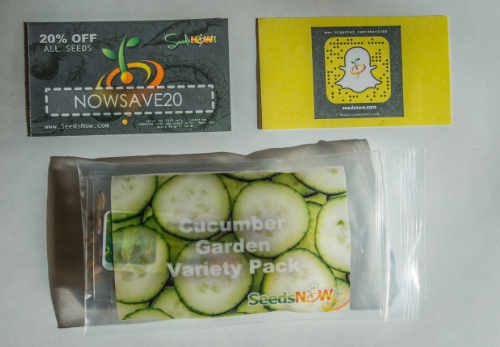
1. Ashley Cucumbers
2. Boston Pickling Cucumbers
3. Chinese Snake Cucumbers
4. Homemade Pickling Cucumbers
5. Lemon Cucumbers
6. Marketer Cucumbers
7. Markemore Cucumbers
8. National Pickling Cucumber
9. Spacemaster Cucumbers
10. Straight Eight Cucumbers
11. Tendergreen Burpless Cucumbers
12. White Wonder Cucumbers
Read the full descriptions here.
 Cucumbers are a warm season vegetable, in that they must be planted after all chance of frost has pasted. Tomatoes are the same way and can usually be planted in the Front Range by May 15th. Remember that retailers stock two major pushes of annuals plants. The first one arrives around April 15th and will last a few weeks. The second one starts a month after the first, because a frost may show up and force everyone to buy a second round of plants. In this way the retailers can sell two rounds of plants instead of just one. All because people got big eyes and bought all the colorful plants before they should have.
Cucumbers are a warm season vegetable, in that they must be planted after all chance of frost has pasted. Tomatoes are the same way and can usually be planted in the Front Range by May 15th. Remember that retailers stock two major pushes of annuals plants. The first one arrives around April 15th and will last a few weeks. The second one starts a month after the first, because a frost may show up and force everyone to buy a second round of plants. In this way the retailers can sell two rounds of plants instead of just one. All because people got big eyes and bought all the colorful plants before they should have.
Annual planting starts on May 15th around here, and anything earlier is inviting a late frost and a second expenditure for flowering annual plants. Patience my friend, patience.
After May 20th you can set your seedlings out in your prepared garden space. I like to grow my seedlings indoors about 6 weeks prior to planting outside. If you grow seedlings indoors you will have an earlier first harvest of cukes in about 65-70 days depending on variety.
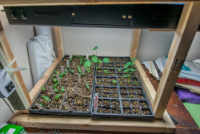 Sometimes I create a temporary light station to give the seedlings the best chance of getting off to a good start. This year I cobbled together a frame using one inch x one inch wood sections screwed together. I hung the T-5 growing light in the middle and placed the plants underneath. I built this one just big enough for two flats.
Sometimes I create a temporary light station to give the seedlings the best chance of getting off to a good start. This year I cobbled together a frame using one inch x one inch wood sections screwed together. I hung the T-5 growing light in the middle and placed the plants underneath. I built this one just big enough for two flats.
It's a little out of square, but since I use star bits I can easily back out the screws and straighten this out. Probably won't. I keep this in my studio, right next to this stand is a 44" wide printer, four guitars, several mics, electronic equipment on the floor and photographic equipment on most of the shelves. This is a working studio but in the corner sits this little light stand.
And underneath is an ever changing array of new plants. Everyone comes down to look at them.
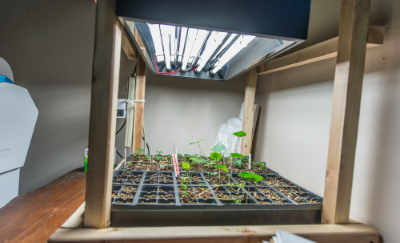
Underneath the light fixture sits 4 T-5 bulbs tuned to 6700 K. This is an ideal seedling light because it is so gentle on the plants. I spent about $55 on it and I seem to find all sorts of uses for it. It is only good to get plants going, if you want to continue to keep them under a grow light as they get bigger, you will have to use a stronger LED light as they get bigger. But for seedlings this is great. It also consumes very little energy.
I am starting to see grow lights for sale in many retail outlets. Costco sells a few very inexpensive lights now, but I prefer the more professional grow lights like this one. You can lower it to almost the top of the plants without burning them.
So the cucumbers are on the left hand side in the two smaller images and behind the hummingbird mix in this bigger picture.
Here you can see the new seedlings with their first true leaves emerging. The first set are not true leaves, but instead cotyledons which are actually the two seed halves that the plant has now pulled above ground. It feeds the plant until it can get the first true leaves out which will start up the energy production engine of the plant.
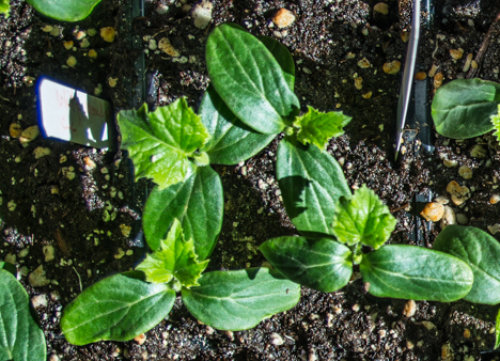
As I was reading through the planting instructions I noticed they recommend against using potting soil and instead recommend a soilless medium compromised of peat moss, vermiculite and perlite. This is a standard hydroponics mix and is very good for seedlings. Not being satisfied with just great medium, I substituted sand for vermiculite and added a 40% increase in volume with worm castings. Mixed well, this will cause any seedling to jump out of the ground, in a good way. The worm castings will not create a "hot" soil and will instead provide just the right food charge for the newly emerging plants.
I am a big believer in these non soil mixes for several reasons. For one, bugs do not generally like this mix and will stay away. There is very little to eat for a bug in this non soil mix. So you get the upper hand on bug control right away. Second the drainage is superior and this mix will never harden up. Plants will have an easy time running their roots deep in it. Another reason is that I can control exactly what the plants get to eat. Since there are no nutrients present in the mix, all nutrients must be added. Now if you use a standard run of the mill fertilizer, this may not matter. However I learned something from some other growers in this valley and found some plant nutrients for high value crops, if you know what I mean.
These fertilizers represent the very best quality fertilizers I can find and they have the added benefit of being not only organic vegetarian but also vegan. That is the only fertilizers I want to use when my family is concerned. Just be ready for some serious sticker shock. And these are more involved to use. They must be mixed and then properly pH'ed in order for the plants to take up optimal and maximum amounts of nutrients and elements. This is one benefit of the blossoming marijuana cultivation business, in that they are bringing new products to market that can easily be applied to growing vegetables at home, even in the Winter. I hope to write more about this over next Winter.
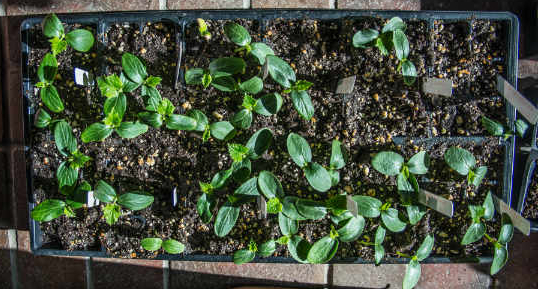
As for these cucumbers they are being grown for the backyard garden, under full Sun, in natural soil (after they are transplanted), and watered with the backyard irrigation system and supplemental feedings by hand. Tomato cages are used to keep the cucumbers off the ground, lattices can also be used. Mulch is added on top of the soil mix to keep the soil moist at all times. By planting seedlings you can get a two week jump on the time to harvest and a second sowing of seeds should occur about four weeks later for a second crop. The seeds can be sown right next to the existing plants. This will extend your season deep into Summer and for some varieties into Fall.

Cucumbers are a favorite vegetable around our house and offer varieties for slicing and serving in salads and some for pickling and holding for Winter. With a little creativity and leadership you can involve the whole family in the process and grow healthy and enjoyable garden vegetables with no pesticides.
What about my wife? What does she do? She is involved in growing the Lemon Basil and herb garden. it is a small row for a busy person but it serves a big purpose, gets her involved and when we sit together around the table, she can tell us all about the herb garden and the cukes in the salad, and somehow we all come together over that.
 Seednow Varieties
Seednow Varieties